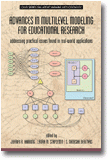
Advances in Multilevel Modeling for Educational Research
Addressing Practical Issues Found in Real‐World Applications
Edited by:
Jeffrey R. Harring, University of Maryland
Laura M. Stapleton, University of Maryland
S. Natasha Beretvas, The University of Texas at Austin
A volume in the series: CILVR Series on Latent Variable Methodology. Editor(s): Gregory R. Hancock, University of Maryland.
Published 2015
The significance that practitioners are placing on the use of multilevel models is undeniable as researchers want to both accurately partition variance stemming from complex sampling designs and understand relations within and between variables describing the hierarchical levels of these nested data structures. Simply scan the applied literature and one can see evidence of this trend by noticing the number of articles adopting multilevel models as their primary modeling framework. Helping to drive the popularity of their use, governmental funding agencies continue to advocate the use of multilevel models as part of a comprehensive analytic strategy for conducting rigorous and relevant research to improve our nation’s education system.
Advances in Multilevel Modeling for Educational Research: Addressing Practical Issues Found in Real‐World Applications is a resource intended for advanced graduate students, faculty and/or researchers interested in multilevel data analysis, especially in education, social and behavioral sciences. The chapters are written by prominent methodological researchers across diverse research domains such as educational statistics, quantitative psychology, and psychometrics. Each chapter exposes the reader to some of the latest methodological innovations, refinements and state‐of‐the‐art developments and perspectives in the analysis of multilevel data including current best practices of standard techniques.
We believe this volume will be particularly appealing to researchers in domains including but not limited to: educational policy and administration, educational psychology including school psychology and special education, and clinical psychology. In fact, we believe this volume will be a desirable resource for any research area that uses hierarchically nested data. The book will likely be attractive to applied and methodological researchers in several professional organizations such as the American Educational Research Association (AERA), the American Psychological Association (APA), the American Psychological Society (APS), the Society for Research on Educational Effectiveness (SREE), and other related organizations.
CONTENTS
Foreword, Sophia Rabe‐Hesketh. Preface, Jeffrey R. Harring, Laura M. Stapleton, and S. Natasha Beretvas. Acknowledgements. PART I METHODOLOGICAL ISSUES IN MULTILEVEL MODELS. The Discrepancy between Measurement and Modeling in Longitudinal Data Analysis, Daniel J. Bauer and Patrick J. Curran. Incomplete Multilevel Data: Problems and Solutions, Joop Hox, Stef van Buuren, and Shahab Jolani. Sampling Weight Considerations for Multilevel Modeling of Panel Data, Laura M. Stapleton, Jeffrey R. Harring, and Daniel Y. Lee. Residual Diagnostics and Model Assessment in a Multilevel Framework: Recommendations toward Best Practice, Ann A. O’Connell, Gloria Yeomans‐Maldonado, and D. Betsy McCoach. PART II HANDLING LONGITUDINAL DATA COMPLEXITIES: CROSSCLASSIFIED AND RANDOM EFFECTS LATENT VARIABLE MODELS. Multilevel Cross‐Classifi ed Testlet Model for Complex Item and Person Clustering in Item Response Data Analysis, Hong Jiao, Akihito Kamata, and Chao Xie. General Random Effect Latent Variable Modeling: Random Subjects, Items, Contexts, and Parameters, Tihomir Asparouhov and Bengt Muthén. N‐Level Structural Equation Model of Student Achievement Data Nested with Repeated Teachers, Schools, and Districts, Paras D. Mehta and Yaacov Petscher. A Model for Cross‐Classifi ed Nested Repeated Measures Data, Jeffrey R. Harring, S. Natasha Beretvas, and Anita Israni. Cross‐classified Random Effects Models for Assessing Rater Severity and Differential Rater Functioning, S. Natasha Beretvas, Daniel L. Murphy, and Matthew N. Gaertner. PART III. CAUSAL INFERENCE AND ADVANCED PSYCHOMETRIC MODELS. Handling Measurement Error in Predictors with a Multilevel Latent Variable: Plausible Values Approach, Ji Seung Yang and Michael Seltzer. Mixture Modeling Methods for Causal Inference with Multilevel Data, Jee‐Seon Kim, Peter M. Steiner, and Wen‐Chiang Lim. Multilevel Social Network Models: Incorporating Network‐Level Covariates into Hierarchical Latent Space Models. Tracy Sweet and Qiwen Zheng. Biographies.
-
Paperback9781681233277
Web price: $45.04 (Reg. 52.99)
-
Hardcover9781681233284
Web price: $80.74 (Reg. 94.99)
- eBook9781681233291

- EDU000000 - EDUCATION: General
- EDU027000 - EDUCATION: Statistics
- EDU029040 - EDUCATION: TEACHING METHODS & MATERIALS: Social Science
-
 (Re)Envisioning Social Studies Education Research
Current Epistemological and Methodological Expansions, Deconstructions, and Creations
(Re)Envisioning Social Studies Education Research
Current Epistemological and Methodological Expansions, Deconstructions, and Creations
-
 Advances in Latent Class Analysis
A Festschrift in Honor of C. Mitchell Dayton
Advances in Latent Class Analysis
A Festschrift in Honor of C. Mitchell Dayton
-
 Advances in Longitudinal Methods in the Social and Behavioral Sciences
Advances in Longitudinal Methods in the Social and Behavioral Sciences
-
 Beyond Single Stories
Changing Narratives for a Changing World
Beyond Single Stories
Changing Narratives for a Changing World
-
 Distance Learning
Volume 20 #3
Distance Learning
Volume 20 #3
-
 Distance Learning
Volume 20 #4
Distance Learning
Volume 20 #4
-
 Healing While Studying
Reflections and Strategies for Healing, Coping, and Liberation of Graduate Students of Minoritized Identities
Healing While Studying
Reflections and Strategies for Healing, Coping, and Liberation of Graduate Students of Minoritized Identities

